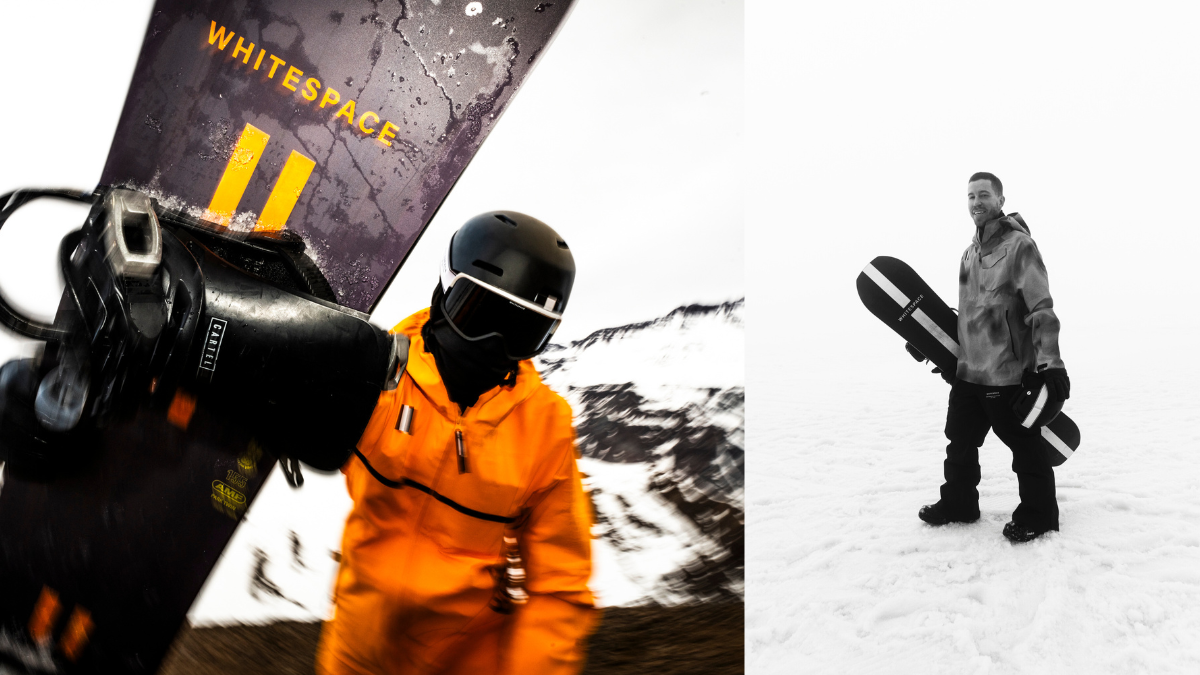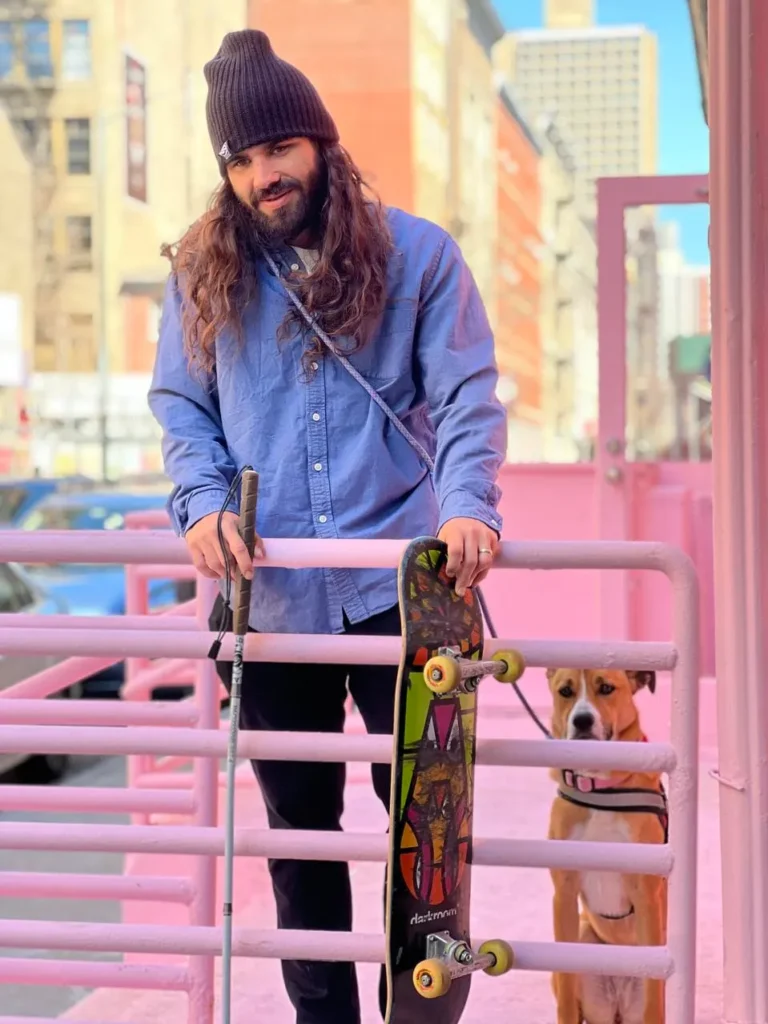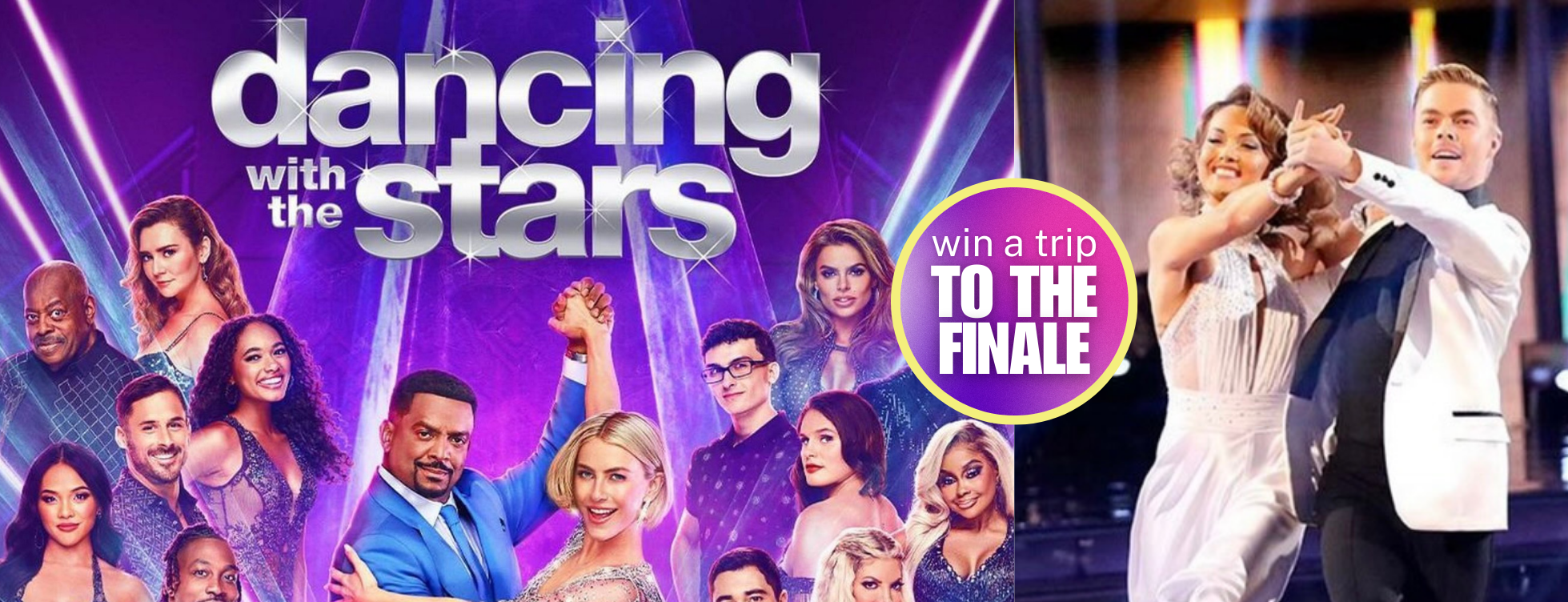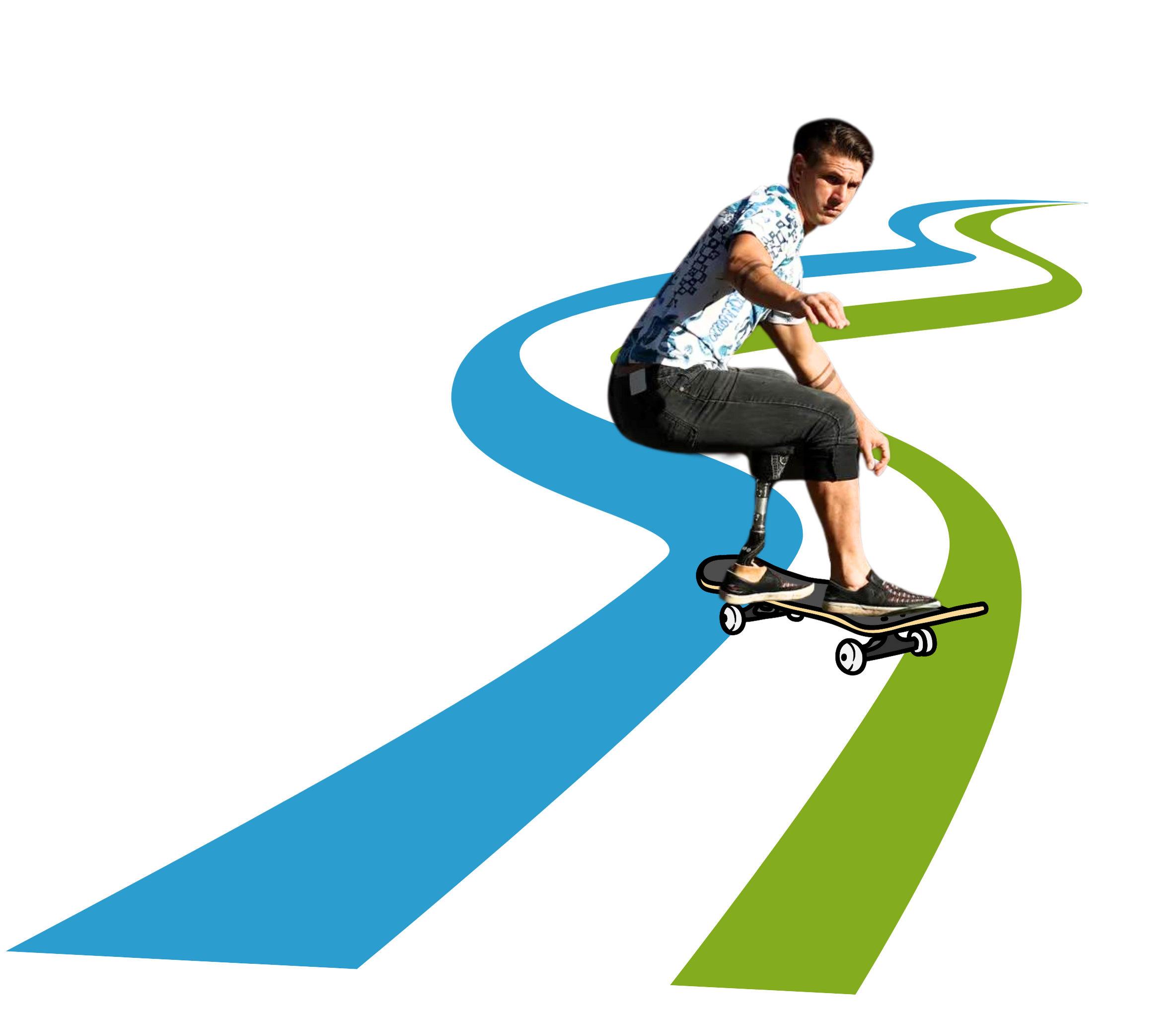
Adaptive Action Sports Announces Partnership with WHITESPACE for the 2024/25 Snowboard Season
Adaptive Action Sports (AAS) announce a new partnership with WHITESPACE for the 2024/25 snow season.
By Michelle Bruton
When Anthony Ferraro and his then-girlfriend, Kelly, made a video in January 2021 about his daily life as someone who was born blind and posted it to TikTok, neither of them had very high expectations.
In fact, Ferraro hadn’t wanted to do it at all; in early 2020, when repetitive TikTok dances were all the rage, he had no interest in the app. But the 27-year-old responded to the shift in TikTok videos that happened as the pandemic—and isolation—continued on for months, leading to more vlog-style snippets of people narrating their day-to-day life, without music or viral sound effects.
When the couple went to sleep that night, Ferraro says, the video had about 100 views and he had 30 followers. The next morning, the video had 40,000 views and Ferraro had gained 1,000 followers.
“I was getting hundreds of these messages that were overwhelmingly positive and that I was inspiring others to keep going, and I got to hear their stories and encourage them on their journey,” Ferraro told me. “My mission statement is if I can help one person, it’s a job well done, and I was getting hundreds of messages. I was like, ‘I think we found our place.’”
In a lot of ways, Ferraro has been searching for his place in the world—and what he is meant to be doing with his life—his whole life, growing up in Spring Lake, New Jersey, the youngest of three brothers.
Today, Ferraro is the picture of success and positivity—he has a spot on Team USA as he attempts to qualify in judo for the 2024 Paris Games, his TikTok videos are seen and enjoyed by his 1.1 million followers, he travels the country for motivational speaking gigs and he’s becoming a household name in skateboarding, so much so that this summer, MTN DEW invited him as an ambassador to events leading up to and including Dew Tour in Des Moines.
Even though he makes it look easy, however, Ferraro’s life has been anything but. And his seemingly boundless energy and positivity haven’t always been innate—rather, they’re a response to the challenges his life has dealt him.
Ferraro was born blind due to a genetic condition called Leber congenital amaurosis, or LCA. Until seventh grade, he traveled from his home on the New Jersey shore to Philadelphia—a journey of about 75 miles one way, every day—to attend St. Lucy Day School for the Blind and Visually Impaired, where being blind and reading braille were the norm, not the exception.
In seventh grade, however, Ferraro transferred to St. John Vianney High School in New Jersey, and the single word he would use to describe the experience is anxiety.
“Because it’s such a crucial age, 13, and I was just trying to be a normal kid,” Ferraro said. “I would never use my cane. I would try so hard to pretend I wasn’t blind; I would tell people I wasn’t, I would put my braille books under my desk, like maybe no one will see that I’m reading braille.” As a result, Ferraro said, he did a lot of overcompensating, trying to be the class-clown type and to laugh everything off.
Before long, however, Ferraro did find his place in high school—on the wrestling team. He racked up more than 100 wins against sighted opponents, which drew the attention of the local media. At first, Ferraro was resistant to the interest in his story as a blind wrestler dominating his able-bodied competition.
“I was like, ‘Why are we doing this?’ There are all these wrestlers that are so much better,” Ferraro said.
But then, the messages started coming in. People, visually impaired and otherwise, thanking Ferraro for just “getting after it every day” and showing the world what was possible.
“It was almost a slap in the face of like, you’re really selfish if you’re not going to accept who you are and use it to try to help people,” Ferraro said. His “if I can help one person” mentality developed then and there.
After high school, Ferraro attended the The College of New Jersey for two years, but after suffering a bad concussion, he stopped wrestling. The sport had been “all he had really known” for the previous six years, and he decided to leave college to figure out what was next.
“You hear people talk about ‘that was the darkest point in my life,’ and leaving college was a pretty dark time because I didn’t know what I was going to do; my future was so unknown,” Ferraro said.
The aimlessness led to depression, and though he credits his family as being a crucial support system, Ferraro knew he needed more tools to move forward. A brief stay in a mental health facility provided a “huge breakthrough,” he said. “I learned it’s okay to actually talk to people and it’s okay to express yourself and not hold all your feelings inside. I was so angry about things, and it really helped me.”
Armed with his new perspective—that he had to embrace who he was and the gifts he had been given in life and use them to help people—Ferraro moved to California in 2015 when he was 19 to try something new. In August, he got the phone call that would shake him to his core: his beloved brother Oliver had died in his sleep of an overdose. No one saw it coming.
“I was so…demoralized. It felt like the floor was ripped out from underneath me,” Ferraro said.
The hits kept coming. Ferraro returned in New Jersey to be with his family. In January, he came home to find his mother lying at the bottom of the stairs in a coma. She had fallen and suffered a traumatic brain injury.
“Life was like boom, boom; I was like, ‘When does this stop, when do I start going uphill again?’” Ferraro said. “I just kept the faith and I just knew I had to keep going.”
Oliver, an aspiring filmmaker who had gone to film school, had shot footage of Anthony’s wrestling matches his senior year as he tried to win the New Jersey state championship and hoped to make it into a feature-length documentary. Chris Suchorsky, an independent film producer, was also capturing footage of Ferraro.
But life, as it does, got in the way, and the film was shelved for about two years as Oliver bought a house and Suchorsky had a child. After a couple years, however, Suchorsky, knowing it was a great story waiting to be told, revisited the project and edited together the film’s first 15 minutes to show Oliver and get the ball rolling.
Two days before Oliver and Suchorsky were supposed to meet and view the footage, Oliver died.
“Chris came to his funeral and said, ‘Whatever it takes, I’m going to finish this film,’” Ferraro said.
Ferraro and Suchorsky put the film, titled A Shot in the Dark, on Kickstarter with a goal of raising $36,000 to complete it. Within four days, it had raised $84,000. The trailer went viral and even attracted the attention of the U.S. Paralympic Committee.
“I was sitting at home and I got a phone call: ‘This is the United States Paralympic Committee,’ and I was like, ‘Sorry, I think you’ve got the wrong number,’” Ferraro chuckled. “And they were like, ‘No, we saw your documentary—if you have any of that talent left, would you consider coming to train for the Paralympics in judo?”
It was 2017, three years before the 2020 Games were set to kick off in Tokyo. Ferraro’s response? “Hell, yeah! This was a once in a lifetime opportunity.”
“My brother was the most ambitious, motivated person I ever knew and when he passed, I felt like that just…surged inside of me,” Ferraro said. “I was like, ‘I have things to do.’ I grieve every day—it’s been seven years, and it never goes away, but it’s just learning to cope with it and talk about it.”
As few things do in life, Ferraro’s Paralympic aspirations didn’t go according to plan. The pandemic hit and the Games were postponed to Summer 2021. Shortly before the rescheduled Games, Ferraro, who was ranked top 20 in the world, had two more qualifying events to earn his spot on the U.S. Paralympic judo team. In a practice, he tore his groin and was out for 8-10 months. No Paralympics.
“It was really brutal; I was grieving that loss, but it also made me realize judo’s not gonna be here every day, it could end tomorrow, so let’s focus on other parts of your life too and make sure there are other things that are going on in your life,” Ferraro said. “That’s when the content creation happened, and falling back in love with skateboarding happened.”
Ferraro started skateboarding as a kid because his brothers did and, as a “typical younger brother,” he just wanted to be around them. The trio built wooden mini-ramps in their driveway, and Ferraro would mostly roll around for fun, because no one really knew how to teach him the fundamentals of skateboarding.
After Oliver died, Ferraro subconsciously “threw his skateboard away.” “Oliver was the one that would build me up, saying, ‘That’s sick, you’re skateboarding and you were born blind!” Ferraro said.
But one day, at his brother John’s house, Ferraro found Oliver’s old skateboard in the basement. “Take it,” John said.
“It was in such good shape, and I just felt this connection every time I stepped on a skateboard after that,” Ferraro said. “He was with me, like he was rolling next to me or something, and I even said in my head every time, ‘This one’s for you, Ollie.’ When I found that board, I just fell in love with it again.”
Two years ago, Kelly drove Ferraro to Michigan for a meetup of blind skateboarders, a trip that progressed Ferraro’s riding significantly. Many were sighted when they skated and then lost their vision later in life, so they knew how tricks were supposed to look and had the muscle memory. “When I met them, I learned a heelflip, I learned how to 50/50—it opened up a whole new world for me,” Ferraro said.
So when Ferraro and Kelly made that video that would go viral in January 2021, Ferraro introduced himself to the world as a skateboarder—and a member of Team USA training for judo in the Paralympics, and a musician, and a surfer.
The video ended with what has become Ferraro’s signature phrase—“one love”—and the world fell in love with him. “It’s just such a positive message, and people started feeling this ‘one love’ feeling of love and friendship and stoke, and that’s really what it’s all about is trying to spread that like wildfire,” he said. “Negativity is contagious, but so is positivity.”
Ferraro’s videos typically begin with him saying, “I’m blind! This is how I…” and then doing anything from cutting a watermelon to bowling to going down a waterslide. The energy is often chaotic, with quick cuts and close-ups of Ferraro in motion—indeed, he rarely stops moving. He credits now-wife Kelly with not only filming all the videos, but sitting down with him beforehand to listen to his vision of what he wants to portray and then bring it to life.
“We’ve just had so much fun telling my story and ultimately trying to push people toward the film,” Ferraro said. Before long, brands came calling, but Ferraro is picky about which opportunities he accepts. “Even if we do things for brands, we try to do it so organic and not an in-your-face ad.”
Indeed, once Kelly came into Ferraro’s life, he really began to blossom and to embrace the possibility of the role he could play for others.
“Since the first time I ever met Anthony, I was kind of in awe of him and everything he was trying to do,” Kelly told me. “I had never met anyone that was so go, go, go—I always felt like I was moving faster than everyone else around me, like no one would ever be able to keep up, and when I met Anthony, he was just as fast.”
“People are like, ‘Is every day easy? How do you always have this positive attitude?’” Ferraro said. “Some days suck, I don’t even want to get out of bed, and they’re like, ‘How do you do it then?’ Kelly really is my rock; she’s like, ‘Anthony, you’re the only one that can crawl out of this hole, but my hand’s here to help you.’”
After all, “Anthony’s biggest battle is with himself,” Kelly says. He can start going down a path of wishing he weren’t blind or wishing his life were different.
But unlike when he was younger and carried that anger around or refused to accept his reality, Ferraro knows now that he has the opportunity—perhaps the responsibility—to affect thousands of other visually impaired people and show them that life doesn’t need to have limits.

And it’s not just about having a partner who helps him navigate through the world or places pillows around the coffee table when they’re staying at an Airbnb. Kelly is focused not just on making life easier on Ferraro, but improving the quality of it.
When they travel overseas, she researches things for blind people to do in different cities, like dining in the dark or tactile gardens. And when the two were married in October 2021, Kelly worked with a special designer to incorporate tactile elements into her wedding dress for Anthony to enjoy, like velvet ribbons and tassels.
In July, the three of us sat down at Dew Tour, as Ferraro had been invited to serve as a MTN DEW ambassador and create content as part of its “Skateboarding is Unstoppable” campaign, which included multiple “Unlock the Spot” events in its pro team skaters’ hometowns. Ferraro traveled to Burlington, Vermont; El Segundo, California; and Kansas City, Missouri, with pro skaters Chris “Cookie” Colbourn, Theotis Beasley and Sean Malto.
Dew Tour does feature an adaptive skateboarding category, but Ferraro wasn’t on the start list in 2022, though he was an alternate. His goal, however, is to compete in his first Dew Tour in 2023.
“At first, Dew Tour seemed impossible, like I’ll never be there, and now it feels closer and closer,” Ferraro said. “Next year is my year.”
Ferraro is also hopeful that adaptive skateboarding will be added to the Paralympics now that it made its Olympic in Tokyo. The program for the Paris 2024 Summer Games is already set, but there’s a possibility the sport could be considered for LA28.
“If it doesn’t happen in LA, even if it happens 20 years from now, that’s a win, but you have to start now with awareness,” he said. “The key is more competitions for adaptive skateboarders.”
Just as we saw in the years leading up to skateboarding’s Olympic debut in 2021, countries around the world built up their skateboarding infrastructure—especially for girls and women—and competitors as young as 11 took up the sport competitively, knowing the Olympics was a potential end goal.
Adding adaptive skateboarding to the Paralympics program will create a pipeline of competitors who can support themselves with endorsements and national team resources as they dedicate themselves to training and attempting to qualify.
Brands can be more inclusive in this regard, as well. We’ve seen clothing and shoe companies make significant strides in adaptive products, such as self-lacing sneakers or shirts without buttons, but there’s a gap in the market when it comes to visually impaired athletes.
Ferraro’s friend and cohost of their Four Bad Eyes podcast, Dan Mancina, is a blind pro skateboarder on the adidas team. “They just did a team shirt and they put braille on it for him, his name in braille,” Ferraro said. “It’s really sick to see these companies getting on the train, and it is a fashion statement too, even if you’re not blind, but then adding that inclusivity is so cool.”
Mancina’s board sponsor, Real Skateboards, also put out a skateboard for visually impaired riders with Mancina’s name in raised ink braille and a notch carved out to indicate which end is the nose. Proceeds from the sold-out board supported Mancina’s goal of building an adaptive skatepark.
Mancina sent his friend and podcast cohost a care package featuring both products, and Ferraro’s excitement about the inclusive features is contagious.
Brand support can mean the difference in whether a skateboarder can manage to pursue action sports professionally or not. It can come down simply to how fast boards and shoes wear out when they’re being put through the ringer daily at the skate park.
“I would love a skateboard sponsor. That’s one thing I’m really working towards right now,” Ferraro said. “Just to be able to continue doing it without the extreme worry of where am I going to get my next board, and the same for shoes.”
Next on the horizon for Ferraro, who is the U.S. national champion in his weight class in judo, is the Pan-American Championship in Canada in December. “I get in competition mode and skateboarding’s my release, and then the second the competition is over, skateboarding becomes my main focus again,” he said.
He also may have found a new sport to serve as a release—or possibly to pursue professionally. In September, Ferraro texted me a video of him snowboarding for the first time at Big Snow American Dream in East Rutherford, New Jersey, a year-round indoor ski and snowboard park.
“I went snowboarding for the first time ever today and I am seriously addicted,” Ferraro wrote. “Going that fast down the mountain is seriously the best feeling in the world.”
Indeed, snowboarding instructors might chuckle at Ferraro “sending it”—he points his nose and flies down the hill flat. Turns will be learned later. Even with skateboarding, Ferraro uses a cane to orient himself. With no cane, flying down the snow, Ferraro said he felt “free.”
Another goal has been added to the list: training to potentially get good enough in adaptive snowboarding to make the U.S. Paralympic snowboarding team ahead of the 2026 Games in Italy.
For Ferraro, the process of learning a new trick on a skateboard or standing up on a snowboard for the first time is a microcosm of how he lives his life.
“You try a trick, and you are so far away from learning that trick on your first attempt, and then you spend three hours there and every 20 tries, this or that adjustment really brings it closer—and then I’m like, ‘This is actually in reach,’” Ferraro said. “And then when you land it, it’s like this explosion, from looking back a couple hours ago and that feeling of ‘I’m never gonna be able to do this’ to landing it, you’re like, ‘Life’s not that bad. If I can do this, I can get down the street with my cane, I can ask for help.’”
Thanks to his large platform and advocacy, Ferraro is bringing those lessons in perseverance—and that overwhelming feeling of accomplishment—to thousands of visually impaired people who might not otherwise think they can take up action sports.
Originally Published by Forbes Magazine

Adaptive Action Sports (AAS) announce a new partnership with WHITESPACE for the 2024/25 snow season.

Enter to Win an Ultimate Experience to attend the Dancing with the Stars Season Finale in Los Angeles alongside former contestant and AAS co-founder, Amy Purdy!

WE’RE OPENING OUR DOORS AND YOU’RE INVITED! Come check out our new headquarters, meet our athletes, and learn how you can get involved. There will
Interested in joining us? Fill out the information below and we’ll send you more information.